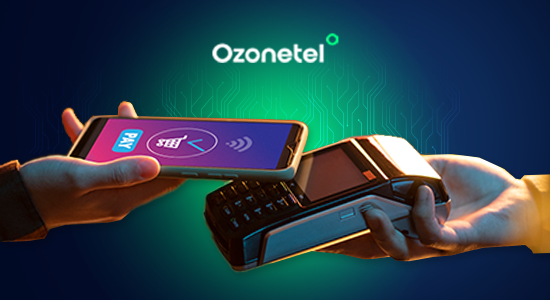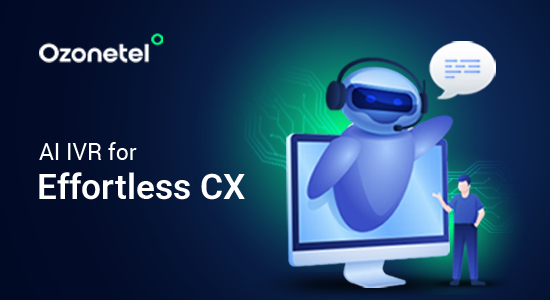- Resources
- How AI is Reshaping Customer Experience in 2024
How AI is Reshaping Customer Experience in 2024

AI Customer Experience (AI CX) uses intelligent technologies to enhance how customers interact with your business. But why is AI so important for improving customer experience?
This is primarily because AI complements human agents, augmenting their capabilities by automating routine tasks, allowing them to focus on more complex issues and deliver personalized experiences with real-time insights.
Now, how exactly is AI shaping customer experience across industries? And more importantly, how can you leverage this technology to meet the growing expectations of your customers? Let’s dive in.
In this article, we will explore:
What is AI Customer Experience?
An AI customer experience uses AI technology—machine learning, chatbots, and digital agents—to deliver fast, efficient, personalized, and proactive experiences at length. An AI CX leverages intelligent technology to improve customer experiences, enable CX teams to work more productively, and help the business save costs.
And if you’re still not convinced, here are some stats to prove the benefits of AI in boosting customer experience:
- AI-driven CX intelligence can help recognize customers who are up to five times more likely to churn because of a poor network experience
- It can recognize opportunities to lower capital expenditure by 5 to 10%
- It can also help generate a 10 to 15% increase in sales conversion
5 AI in Customer Experience Examples
Companies leverage AI to create more personalized, efficient, and engaging customer interactions. Below are some real-world examples showcasing how AI is transforming customer experience.
Bank of America: Erica – AI-Driven Financial Assistant
Bank of America’s AI-powered virtual assistant, Erica, offers a personal touch for customers who miss the human element in banking. Accessible via the bank’s mobile app, Erica helps with routine tasks like checking balances, transferring funds, and scheduling payments.
Voice commands, text inputs, and taps make interactions seamless, while advanced analytics allow Erica to provide smarter, faster service. The bank has plans to expand its capabilities, enabling Erica to help customers save money and perform more complex tasks.
Starbucks: My Starbucks Barista – AI for Ordering and Payment
Available on the Starbucks app, the My Starbucks Barista chatbot allows customers to place orders, ask questions, and even receive drink suggestions through voice or text. The chatbot simplifies the ordering process by offering consistent experiences across platforms, including Amazon Alexa.
Nike: AI-Driven Personalization at Scale
Nike uses AI to deliver personalized product recommendations based on data like browsing behavior, purchase history, and activity levels. For instance, customers browsing running gear might receive suggestions for the latest shoes or apparel tailored to their interests.
Nike also integrates AI into its digital marketing efforts, creating tailored email campaigns and ads based on customer preferences. Additionally, in-store personalization with the Nike app allows users to receive custom product recommendations and exclusive offers when they visit physical locations.
Netflix: AI-Powered Recommendation Engine
Netflix’s AI-driven recommendation engine is key in delivering a tailored viewing experience. By analyzing user behavior, such as viewing history, ratings, and time spent watching certain shows, Netflix curates personalized content suggestions for each viewer.
The platform even customizes movie trailers based on users’ preferences, increasing their chances of watching the recommended content.
Moreover, Netflix’s AI continually evolves based on real-time user interaction, ensuring viewers discover new shows and movies that match their unique tastes, ultimately keeping them engaged on the platform.
Amazon: AI-Enhanced Supply Chain for Faster Deliveries
Amazon uses AI to speed up its supply chain and improve delivery efficiency. AI-driven systems forecast daily product demand, restock warehouses, and ensure faster deliveries, especially during high-demand periods like Cyber Monday. By automating these processes, Amazon has reduced human effort, increased delivery speed, and saved significant costs.
10 Ways AI Can Help Improve Customer Experience
Here’s how an AI-powered customer experience may improve customer happiness, empower teams to work more productively, and ultimately improve your business’s financial performance.
Conversational Intelligence
AI-powered conversational intelligence helps improve sales interaction quality by analyzing customer call data. This analysis lets your team adjust sales tactics and scripts to encourage more property visits.
Benefits:
- Identify patterns in successful sales conversations: AI helps track customer sentiment, tone, and key phrases used during conversations, revealing which approaches lead to scheduled visits.
- Monitor sales team performance: You can track individual agent effectiveness and identify areas for improvement.
- Improve conversion rates: By continuously refining sales scripts based on data, agents can more effectively secure property visits, ultimately leading to more sales.
How You Can Do It:
- Platforms like Ozonetel enable real-time monitoring and analysis of sales conversations, breaking down key metrics like tone of voice, keyword usage, and customer response times.
- Train sales teams using insights from AI analysis. Highlight what worked in successful conversations and tweak scripts accordingly.
- With Ozonetel’s real-time monitoring capabilities, alerts can be set for missed opportunities, such as when an agent fails to pitch a property visit.
Predictive Customer Service
AI-powered predictive analytics uses data to anticipate customer needs and problems before they arise. This allows businesses to offer proactive customer service, resolving issues or providing solutions ahead of time.
Benefits:
- Prevent customer churn: By analyzing data such as purchase history, website behavior, or past interactions, AI can flag customers likely to leave and allow you to intervene with retention offers.
- Increase customer satisfaction: Proactively addressing issues creates a smoother customer experience, reducing frustration and building trust.
- Enhance operational efficiency: Anticipating issues before they occur allows customer service teams to focus on resolving complex problems rather than reacting to avoidable issues.
How You Can Do It:
- Deploy AI tools to track customer behavior patterns and identify early signs of dissatisfaction or churn risk.
- Offer targeted interventions such as discounts, personalized communications, or exclusive deals to customers flagged as high-risk.
- Create automated alerts that notify customer service teams when a predictive model indicates a customer might require immediate attention.
Hyper-Personalization
Hyper-personalization is the next step in customer experience, where AI tailors every aspect of a user’s interaction with a brand. AI can provide individualized recommendations, promotions, and content by leveraging data on a customer’s behavior, preferences, and purchase history.
Benefits:
- Increased customer loyalty: Personalized experiences build stronger connections between customers and your brand, encouraging repeat business.
- Higher engagement: Customers are more likely to interact with content and offers that are specifically relevant to them.
- Boost in sales: It drives purchasing decisions, as customers feel more inclined to buy when the product recommendations align with their preferences.
How You Can Do It:
- Use AI to analyze customer data from multiple sources (website activity, social media interactions, past purchases) to build a complete profile of each customer.
- Implement personalized recommendation engines on your website or app to suggest products or services based on user preferences.
- Create AI-driven email campaigns that send tailored offers to customers based on their purchase history and browsing behavior.
Sentiment Analysis
Sentiment analysis leverages AI to understand customer emotions and opinions through feedback, reviews, and social media interactions. This technology allows businesses to measure customer sentiment at scale, providing valuable insights into how customers feel about their brand, products, or services.
Benefits:
- Improved customer experience: By understanding how customers feel, businesses can make targeted improvements in products or services.
- Quicker resolution of negative feedback: Identifying negative sentiment early allows you to address issues before they escalate.
- Enhanced brand reputation: Monitoring and responding to customer feedback shows that you care about their opinions, fostering positive relationships.
How You Can Do It:
- Integrate sentiment analysis tools that scan customer feedback from social media, review platforms, and surveys.
- Analyze feedback data to identify common pain points or recurring issues and take proactive steps to resolve them.
- Use AI to categorize sentiment (positive, negative, neutral) and prioritize responses, ensuring critical issues are handled promptly.
Chatbots
Chatbots are a widely adopted AI solution that provides instant, round-the-clock customer support. These AI-powered assistants can handle common customer queries, guide users through your website, and even assist with troubleshooting simple issues.
Benefits:
- 24/7 customer support: Chatbots allow customers to get help anytime, improving satisfaction by eliminating wait times.
- Cost reduction: Automating simple tasks frees human agents to focus on more complex inquiries, saving resources.
- Consistent user experience: Chatbots deliver standardized answers, ensuring customers receive clear and accurate information every time.
How You Can Do It:
- Set up chatbot functionality on your website, mobile app, or messaging platforms. Ensure the chatbot can handle FAQs, direct customers to the right resources, and escalate issues when necessary.
- Train your chatbot using past customer interactions to ensure it delivers accurate responses and continuously improves.
- Monitor chatbot performance by tracking user satisfaction rates and the number of successful interactions, then fine-tune the bot as needed.
Omnichannel Experience
A seamless omnichannel experience ensures that customers can interact with your brand across multiple platforms—online, in-store, mobile, or social media—without disruptions.
Benefits:
- Enhanced customer satisfaction: Customers can transition between channels smoothly, making a more pleasant shopping experience.
- Increased sales: By offering a unified experience across all platforms, customers are more likely to complete their purchase, no matter where they are in their buying journey.
- Better customer retention: Seamless experiences build brand loyalty, encouraging customers to return since their preferences and interactions are consistently recognized.
How You Can Do It:
- Integrate AI tools that track customer interactions across all channels (e.g., online store, app, in-person, and social media) to create a unified customer profile.
- Leverage AI-powered CRM systems that centralize customer data, enabling all departments to access consistent information for seamless interactions.
- Ensure consistent messaging by automating communication between channels using AI and providing personalized promotions, updates, or reminders wherever customers engage.
Customer Segmentation
AI helps businesses analyze customer data to create detailed segments based on various factors such as demographics, behaviors, and purchasing patterns. These segments allow companies to offer tailored experiences, ensuring each group receives relevant content, offers, and interactions.
Benefits:
- Personalized customer experiences: Targeted messaging and promotions that resonate with specific customer groups improve engagement and response rates.
- Better marketing efficiency: By focusing on high-potential segments, businesses can reduce wasted ad spend and improve return on investment (ROI).
- Increased customer loyalty: Personalized communication fosters stronger customer relationships, encouraging repeat business.
How You Can Do It:
- Use AI to analyze customer data from multiple sources, including purchase history, website behavior, and social media engagement, to identify key segments.
- Implement AI-driven marketing tools that deliver customized offers, promotions, and recommendations to different customer segments.
- Regularly refine customer segments by analyzing how different groups respond to your marketing efforts, using AI to adjust strategies for maximum relevance and effectiveness.
Voice Assistance
Voice-based support through AI-powered virtual assistants such as Siri, Alexa, and Google Assistant is becoming increasingly popular for improving customer experience. These tools provide instant, hands-free assistance, helping customers access information, perform tasks, or make purchases quickly. For example, Domino’s Pizza allows customers to order pizzas through voice assistants, providing a hassle-free ordering experience.
Benefits:
- Convenient, hands-free interactions – Customers can get assistance or make purchases without using a device manually.
- Instant support – AI voice assistants can respond to queries in real time, improving response times and customer satisfaction.
- Increased accessibility – Voice-based support caters to a wide range of customers, including those with disabilities or those on the go.
How You Can Do It:
- Deploy AI voice assistants that integrate with your existing platforms to assist customers with queries, orders, or account information.
- Train your voice assistants using customer data and preferences to provide personalized responses and recommendations.
- Monitor voice interactions to ensure your AI systems continually learn and improve, offering better, more accurate customer experiences over time.
Self-Service Tools
AI-based self-service tools, like chatbots and automated knowledge bases, can handle common queries, direct users to relevant resources, and even provide recommendations based on customer behavior. This reduces the workload on support teams and allows businesses to offer 24/7 support.
Benefits:
- Reduced support costs: Self-service tools handle routine inquiries, allowing your team to focus on more complex problems.
- Improved customer satisfaction: Customers can resolve issues quickly, even outside regular business hours.
- Data-driven insights: AI can track common customer queries, providing you with insights on where to improve your services or make content more accessible.
How You Can Do It:
- Integrate AI chatbots on your website or app to answer common questions instantly and direct users to additional resources.
- Analyze chatbot interactions to identify patterns or frequent queries, then update your knowledge base or customer journey to address those issues more effectively.
- Create a feedback loop where AI tools monitor user interactions and suggest improvements to your self-service content, such as refining FAQs or tutorials.
Customer Analytics
- AI allows businesses to gather, structure, and analyze large volumes of customer data, enabling deeper insights into user behavior and preferences. With AI-driven customer analytics, companies can understand past behavior and predict future actions. For example, Capital One uses its voice assistant, Eno, to analyze customer behavior and provide real-time financial insights, offering personalized spending advice and account alerts.
Benefits:
- Better understanding of customer needs: AI analytics provides granular insights, helping businesses anticipate customer expectations.
- Reduced churn: By identifying at-risk customers early, you can proactively address their needs and improve retention rates.
- Improved decision-making: AI provides actionable data, helping you make informed decisions about marketing, product development, and customer support.
How You Can Do It:
- Implement AI-powered analytics platforms to track and analyze customer behavior, from purchasing habits to support interactions.
- Use AI to predict future behavior, allowing you to offer solutions or promotions that align with customer needs proactively.
- Identify at-risk customers using AI insights, then take action to address their concerns, such as offering personalized incentives or improved support.
Best Practices for Onboarding New Customers
With a streamlined approach in place, you will be able to make your consumers feel appreciated from the outset. Here are some clients onboarding best practices to assist you accomplish this:
Know Your Audience
Understanding your customers’ unique needs and journey is crucial to crafting a personalized onboarding experience. Each customer subscribes for a specific reason, and your onboarding process should be designed to meet them where they are, not where you think they should be.
Here are some ways that you can use to tailor your onboarding approach:
- Customize the Experience: Use the data you have on your customer’s journey and segmentation to customize every aspect of the onboarding process, from the content they receive to the communication methods you use.
- Integrate with Their Processes: If your product requires them to change existing workflows, offer support to help them smoothly transition. Show them how your solution can enhance or replace their current processes without causing disruption.
- Highlight Key Outcomes: Remind them of the outcomes that initially led them to choose your product. Focus on the features and benefits that address their specific pain points and goals.
Set Clear Onboarding Goals
These objectives will guide your efforts and keep your process on track. But ensure your goals are SMART: Specific, Measurable, Achievable, Relevant, and Time-bound. They should address your customers’ challenges and lead them to significant “aha moments.” Some examples for this are:
- A customer reports gaining an extra hour each day after just one week of using your software.
- The customer opts for a paid service after completing a two-week free trial.
- The customer experiences a 40% boost in website traffic within two months of using your product.
With clear goals in place, your team can build a more focused and effective onboarding process.
Select the Best Onboarding Model
Choose an onboarding model that fits your target customers and the complexity of your product. Here are three primary models to consider:
Self-Service Model
This model lets customers onboard themselves at their own pace. It’s best suited for straightforward B2C products with a large user base. This model is often used by mobile apps for quick and easy setup.
High-Touch Model
The high-touch model offers a more personalized approach, with dedicated customer success representatives guiding the onboarding. This method is ideal for complex products that require tailored support, though it demands more resources.
Low-Touch Model
A middle ground between self-service and high-touch, this model combines automated support with some human interaction, like chat support or email campaigns. It’s suited for products that require some explanation but not extensive in-person training.
If you’re unsure which model is right for your business, consider gathering feedback from your customers to better understand their needs. This will help you develop a more tailored onboarding strategy.
Document Cross Functional Workflows
To ensure a smooth onboarding process, it’s important to clearly define how different roles and teams will collaborate at each stage. Outline how responsibilities are handed off between sales, onboarding specialists, support, success managers, and others involved.
Establish standardized processes to keep onboarding consistent, even when multiple teams are involved. This strategic approach not only ensures that the process is well-coordinated across the customer lifecycle but also promotes accountability by setting clear metrics and workflows. The result is a streamlined onboarding journey that aligns with both customer needs and company goals.
Maintain Momentum
Starting strong is crucial, but sustaining that energy is what truly ensures long-term success. It’s common for customers to eagerly try out a new tool or process in the first few days, but as they revert to old habits, enthusiasm can wane.
To prevent this, it’s essential to maintain—or even amplify—momentum after the initial sale. But how do you do this?
- Make it a priority to connect with your new customers on the first day. Understand their goals and challenges, and use this insight to tailor your support.
- Based on their early interactions with your product, identify and spotlight opportunities where they can derive more value. This keeps them engaged and motivated to explore further.
- Take the time to learn how they plan to use your products and services. This will enable you to offer relevant advice and ensure they fully integrate your solution into their routine.
Clearly Demonstrate Value
Getting your customer excited about your product is essential, but it’s only the first step. The real key to successful onboarding is to clearly demonstrate the specific value your product brings.
Show your customers how your product addresses their pain points by walking them through exactly how it solves their problems. This can be done by guiding them through specific actions or features (“X, Y, Z”) that directly impact their needs.
Use relevant examples to make your points clear. This level of specificity keeps customers engaged and motivated to continue their onboarding journey. You can introduce these value points during kick-off calls, in specialized training sessions, or through personalized in-app messages.
Collect Feedback
Gathering feedback from customers is essential for refining your onboarding process. Customers often have valuable insights on what works and what doesn’t. By listening to their input and making necessary adjustments, you can streamline the onboarding experience. This not only improves outcomes but also shows customers that their opinions are valued, making them feel more involved and appreciated in the process.
Use Automation
Automation can be a powerful ally in your onboarding strategy, helping you maintain consistent communication and engagement without overwhelming your team. In coordination with marketing, sales, and customer success teams, you can leverage the built-in functionality of your customer success platform to keep the onboarding process moving smoothly.
Here are some ways that you can use automation to the best of its ability:
- Trigger Timely Communications: Set up automated emails or messages that reach out to customers at key moments, such as after they’ve completed a significant action or reached a milestone.
- Reinforce Key Benefits: Use automation to send reminders of the product’s core benefits, ensuring that customers continuously see the value in what they’re using.
- Share Training Resources: Automatically share tips, tutorials, or training content that aligns with the customer’s journey and preferred communication channels.
Great Customer Onboarding Examples
Now that you have a good knowledge about customer onboarding, let’s look at a few examples to understand what the process looks like in reality.
Grammarly
Grammarly’s onboarding is built around the concept of learning by doing. Instead of overwhelming users with information, Grammarly provides an interactive demo document right after the initial product tour. Users engage with the tool by correcting errors in the demo, which not only teaches them how to use Grammarly but also educates them on writing best practices.
Key Highlights:
- Interactive Demo: Users start with a real-life example, making the learning process more engaging.
- Sequential Learning: Grammarly guides users step-by-step, allowing them to learn from their mistakes and understand each correction.
- Immediate Value: Within minutes of signing up, users grasp the platform’s functionality and see its potential to improve their writing.
Slack
Slack has mastered the art of customer onboarding with its engaging and minimalistic approach. Right from the start, users are greeted with a fun, simple signup process and a friendly “Tada!” welcome message. Slack doesn’t overwhelm new users with too much information. Instead, it introduces its core features gradually, using empty states and Slackbot (their chatbot) to guide users through the platform.
Key Highlights:
- Personalized Experience: During signup, Slack adapts the images based on user inputs, making the onboarding feel more personal.
- Interactive Walkthrough: Slackbot hosts the product tour, encouraging users to take actions that help them understand the platform.
- Contextual Learning: Instead of a long tour, Slack introduces features like Threads and Activity through empty states, where users learn by doing.
MailChimp
For B2B brands like MailChimp, onboarding often involves integrating the new tool into an existing tech stack. MailChimp excels by making these integrations straightforward and user-friendly. They offer a wide array of software integrations with just a few clicks, reducing the complexity that users might face.
Key Highlights:
- Automated Setup: Automate as much of the integration process as possible to ease the onboarding for your customers.
- Optional Steps: MailChimp offers flexibility, allowing users to skip certain setup steps if they’re not relevant to them.
- Support: Ensure there’s ample support available, as even the most tech-savvy users may need help during integration.
Duolingo
Duolingo flips the typical onboarding process by letting users experience the product before they even sign up. This approach, known as gradual engagement, draws users in by showing them the value of the platform right away. Users start by choosing a language and completing a quick translation exercise. Only after experiencing the product’s core benefits are they prompted to create an account.
Key Highlights:
- Goal Setting: Users choose a learning goal upfront, increasing their likelihood of sticking with the app.
- Progress Tracking: A progress bar during lessons helps users see their advancement, motivating them to continue.
- Deferred Sign Up: Duolingo allows users to explore before asking them to register, making the signup feel like a natural step in the process.
Netflix
Netflix makes the onboarding process incredibly smooth and straightforward. They use a one-month free trial to draw users in, combined with a simple signup process that clearly explains what to expect. Once inside, Netflix is designed to be intuitive, so users don’t need much guidance on how to navigate or use the platform.
Key Highlights:
- Clear Communication: Netflix clearly outlines the free trial details and the cost afterward, so there are no surprises.
- Intuitive Design: The platform’s design meets user expectations, making it easy to use without much instruction.
- Personalized Recommendations: After setting up, Netflix quickly starts feeding users personalized content based on their preferences.
Measuring the Success of Onboarding
To measure the success of your customer onboarding process, you need to rely on specific metrics that reflect how well new customers are adapting to your product. Start by tracking key performance indicators (KPIs) such as:
- Time to First Value (TTFV): This metric measures the time it takes for a customer to experience the initial value of your product. The shorter this time, the more effectively your onboarding process is demonstrating the product’s benefits.
- Onboarding Completion Rate: This metric tracks the percentage of new users who complete the entire onboarding process. A high completion rate suggests that your onboarding steps are clear and engaging, helping users become comfortable with your product.
- Customer Engagement: Monitoring customer engagement involves tracking how often new users log in, how much time they spend on the platform, and how many features they use. High engagement levels indicate that users are actively interacting with your product and finding it useful.
- Retention Rate: This metric reflects the percentage of customers who continue to use your product after the onboarding process. A high retention rate indicates that your onboarding process successfully integrates users into your product, keeping them engaged over time.
- Customer Churn Rate: This metric tracks the percentage of customers who stop using your product after onboarding. A lower churn rate suggests that your onboarding process is effectively retaining users by addressing their needs and expectations.
- Onboarding Dropout Rate: This metric identifies the percentage of users who abandon the onboarding process at various stages. Monitoring this can help pinpoint areas where users might be encountering difficulties, allowing you to refine those steps for a smoother experience.
- Customer Satisfaction and NPS Scores: Collecting feedback through surveys or Net Promoter Score (NPS) surveys provides insight into how satisfied customers are with the onboarding process. High scores suggest that users are pleased with their experience, while lower scores can indicate areas for improvement.
Questions to Ask When Evaluating Your Onboarding Process
Apart from measuring these metrics; you can also make a list of questions to assess the success of your customer onboarding process. Some examples include:
- Where does a new user require several follow-ups? What can you do to reduce this?
- Can users readily traverse self-service choices to reach their ‘aha’ moment?
- Have you provided multiple options for customer support?
- Is it easy for customers to find the “aha” moment when navigating self-serve options?
- What onboarding metrics do you use to assess the effectiveness of your onboarding flow? Are they providing you with accurate, actionable data?
- Are clients gaining faith in your product from the first use?
- Do you have a customer onboarding checklist that you regularly review?
- Are you using client feedback to improve your onboarding strategy?
Conclusion
As AI advances, the potential for improving the customer experience grows exponentially. From emotion-sensing AI that understands and responds to human emotions to immersive experiences powered by augmented and virtual reality, the future of AI in customer experience promises to be more intelligent, sympathetic, and engaging than ever before.
Ozonetel’s AI-powered customer experience platform helps organizations orchestrate and streamline customer journeys from start to finish across multiple digital touchpoints. Enterprises can now power and manage millions of digital customer interactions across WhatsApp, social media, SMS, and other advanced messaging channels. These digital channels work seamlessly alongside Ozonetel’s voice solutions, enabling a comprehensive customer experience on a single, unified CX platform.
Want to see what Ozonetel can do for your company? Sign up today for a free 7-day trial.
Prashanth Kancherla
Chief Operating Officer, Ozonetel Communications
Over the past decade, Prashanth has worked with 3000+ customer experience and contact center leaders...
Chief Operating Officer, Ozonetel Communications
Over the past decade, Prashanth has worked with 3000+ customer experience and contact center leaders to comprehensively understand the need for effective and efficient customer communications at every step of their journey with a brand. Deeply embedded in today’s CCaaS ecosystem, he has been instrumental in Ozonetel's growth and contributed in various roles including product management, sales, and solution architecture.
Frequently Asked Questions
Chatbots are rule-based systems designed to handle specific tasks through scripted responses, while Conversational AI uses natural language processing (NLP) and machine learning to understand and respond more dynamically. Conversational AI offers more advanced interaction, handling complex queries across multiple contexts.
Conversational AI focuses on understanding and responding to user inputs within a conversational framework, often relying on predefined responses or NLP. Generative AI, however, creates new content or responses, often without predefined rules, making it more versatile but also less predictable.
If you ask a Conversational AI, “What’s the weather like today?” it might respond with, “Today’s weather in New York is sunny with a high of 75°F.” This response is generated based on real-time data and contextual understanding.
AI refers to a broad field encompassing various technologies that enable machines to perform tasks that typically require human intelligence. Conversational AI is a specialized subset of AI designed specifically for human-like communication, focusing on understanding and generating natural language.
Yes, ChatGPT is a form of Conversational AI that uses deep learning models to understand and generate human-like text responses. It is designed to engage in dynamic, context-aware conversations across a wide range of topics.
Conversational AI is trained using large datasets of human language interactions, which are fed into machine learning models to help the AI understand context, intent, and appropriate responses. This training process involves supervised learning, where the AI is taught to improve its accuracy over time through feedback and adjustments.








